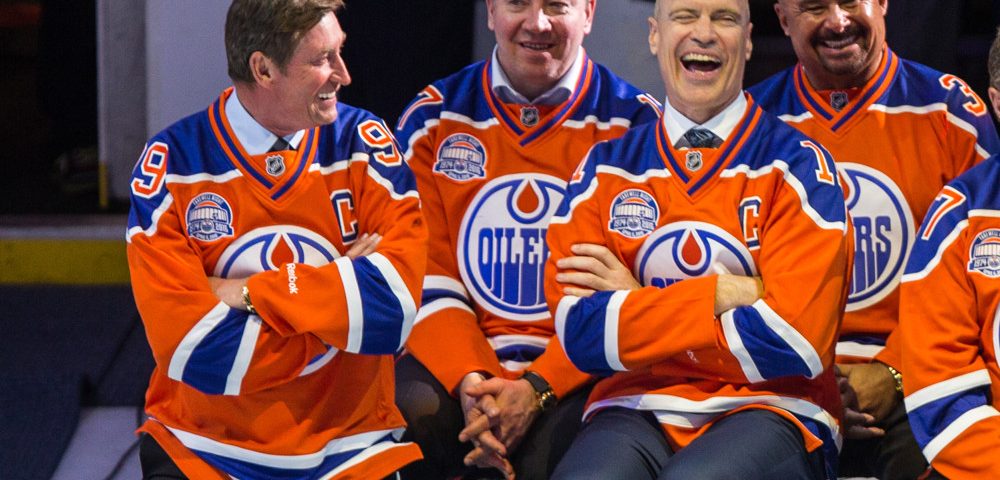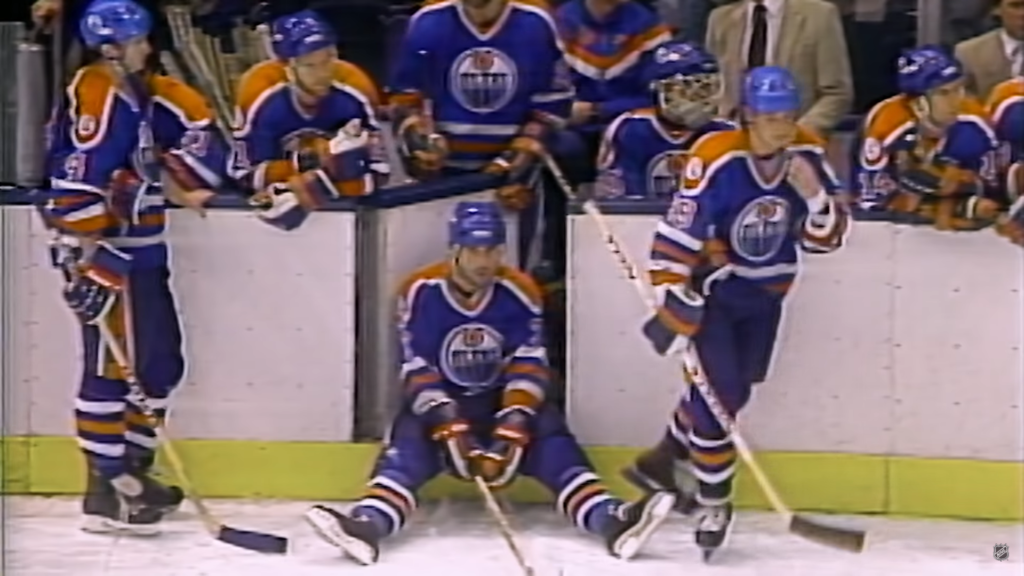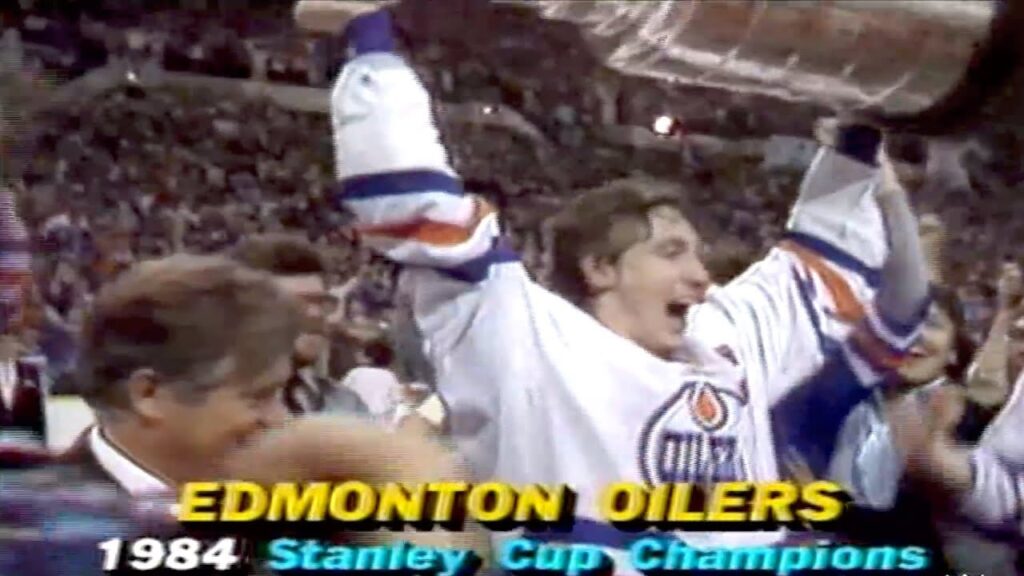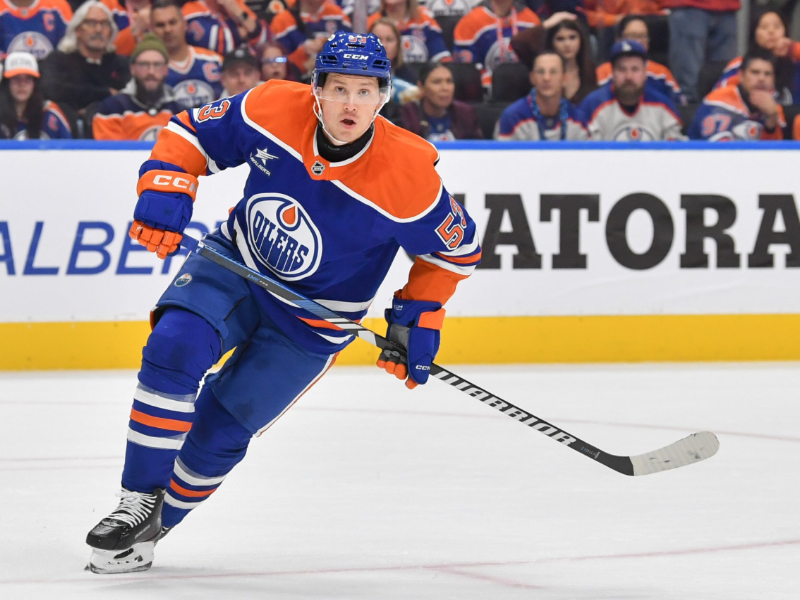
Nugent-Hopkins Gets His 100th Point of the Season
April 6, 2023
Could the Oilers be a team of destiny?
April 11, 2023Can the Edmonton Oilers take the next step? Lessons from the dynasty years, Part One

06 April 2016: Former Edmonton Oilers and hockey legends Wayne Gretzky #99, Jari Kurri #17, Mark Messier #11 and Grant Fuhr #31 enjoy the final ceremony celebrations closing out the final game at Rexall Place. The Farewell Rexall ceremony took place after the Vancouver Canucks game versus the Edmonton Oilers at the last ever NHL hockey game at Rexall Place in Edmonton, Alberta. (Photo by Curtis Comeau/Icon Sportswire)
April 6, 2023 by Bruce McCurdy
The story is a famous one, of Wayne Gretzky and Kevin Lowe passing by the home locker room in the aftermath of the Edmonton Oilers four-game sweep at the hands of the mighty New York Islanders in the spring of 1983. Here is the Great One’s version of it, as told in “his” book (with Rick Reilly) Gretzky: An Autobiography:
Kevin and I loaded up our troubles and our junk and made our way to the bus. We both knew we were going to have to walk by the Islander locker room and we were dreading it: having to see all the happy faces, the champagne shampoos, the girlfriends’ kisses, the whole scene we both wanted so much.
But as we walked by, we didn’t see any of that. The girlfriends and the coaches and the staff people were living it up, but the players weren’t. Trottier was icing what looked like a panful knee. Potvin was getting stuff rubbed on his shoulder. Guys were limping around with black eyes and bloody mouths. It looked more like a morgue in there than a champion’s locker room. And here we were perfectly fine and healthy.
That’s why they won and we lost. They took more punishment than we did. They dove into more boards, stuck their faces in front of more pucks, threw their bodies into more pileups. They sacrificed everything they had.
And that’s when Kevin said something I’ll never forget. He said, “That’s how you win championships.”

This anecdote took on the stuff of legend when the Oilers overcame their demons the very next spring and blew by the Islanders in five games to win their first Stanley Cup. The team had hardened, stiffened its spine, gained the necessary maturity and resolve to see it through to the end.
In truth, by 1984 the Oilers were a year better, the Islanders a year older. When the two clubs met up in a Stanley Cup rematch, the Isles were beginning their twentieth playoff series in five years and the cracks were starting to show. With an epic 1-0 win in Game 1 right in Nassau County Coliseum, the Oilers were in the ascendant, ultimately closing out the series with a trio of convincing wins on home ice in Games 3, 4, and 5.
Champagne shampoos ensued. As did, presumably, girlfriends’ kisses.
While that’s the short version of The Road to Success, the real story was, of course, far more complex. What changed for the Oilers in that 12-month interval?
A second question, more relevant to today: might there be some applications to the modern Oilers across the intervening decades? We’ll dig into that aspect in Part 2.
Oilers’ General Manager Glen Sather already had most of his championship roster in place when his team fired and fell short in the spring of 1983. Such personnel changes as he made were more about deployment and role with existing Oilers than with the fabric of the roster.
Those Oilers were considerably younger than the current edition, having joined the NHL just five years earlier with the 18-year-old Wayne Gretzky already on the team. Chief Scout Barry Fraser and his crack staff followed up with the most exceptional three-year cluster in the history of the NHL Draft, selecting six (6) Hall of Famers in the process. By the spring of 1984 all were young veterans who were still in the process of achieving their peak value. In order of age on May 19, 1984:
- Kevin Lowe – 25 years, 1 month
- Jari Kurri – 24 years, 0 months
- Glenn Anderson – 23 years, 7 months
- Mark Messier – 23 years, 4 months
- Wayne Gretzky – 23 years, 4 months
- Paul Coffey – 22 years, 11 months
- Grant Fuhr – 21 years, 8 months
Around that spectacular group, Sather’s job had always been to build a supporting cast capable of getting the job done. While there were a couple of holdovers from the Oilers squad that finished first in the World Hockey Association in 1978-79, there was plenty of work to be done.
Much of it came that eventful summer of 1979, in a messy merger process including an Entry Draft, reclamation draft, expansion draft, amateur free agent signings and a flurry of trades. In short order Sather and titular GM Larry Gordon already had acquired/retained useful role players and future Stanley Cup winners Lee Fogolin, Charlie Huddy, Dave Hunter, Dave Lumley, and Dave Semenko. The fine tuning commenced from there – adding a Randy Gregg here, a Pat Hughes there, a Willy Lindstrom somewhere else – and by the spring of 1983 was nearly complete.
For simplicity we will stick just to the playoff rosters for 1983 and 1984, and for the most part to regulars.

Astonishing to ponder how little Sather did to modify the roster that was convincingly swept by a combined 17 goals to six. No personnel changes at all to the defence and goaltending. Up front, a couple of bottom sixers got moved out, one got acquired and one got promoted from the press box to the line-up. Note how consistent from year to year are the scoring and plus-minus totals right down the lineup, with the biggest upgrades occurring in the revamped bottom-six.
Indeed, the roster that started that 1983-84 campaign (with seven straight wins!) was essentially unchanged from the one that fell in the Final. It wasn’t until December 5 that Sather made his one significant trade, sending out fourth-line centre Tom Roulston in exchange for Kevin McClelland, a raw-boned 21-year-old who had yet to find his true calling in parts of three seasons with the Pittsburgh Penguins. In Edmonton, he stepped right into the lineup at third line centre and added his own brand of edginess, physicality and timely scoring to the mix.
That scoring never got more timely than in Game 1 of the ’84 Finals, when McClelland netted the only goal of the game early in the third period. Another 21-year-old, Grant Fuhr, made it stand up with a brilliant display of goaltending, while the team as a whole played ferocious two- way hockey to upset the four-time champs 1-0, right in their own barn.
For the Oilers, the win brought a glorious end to a ten-game losing streak to those Isles that included both season series 1982-84 as well as that ignominious sweep in the ’83 Finals. That single game – and that single goal by the one newcomer to the team – represented a massive change in Edmonton’s direction that would lead in short order to their first Stanley.
Which isn’t to say there weren’t other changes, but they were internal:
- Fuhr worked his way back into favour after a dreadful sophomore season, and delivered key victories in Games 1 and 3 before being hurt. Andy Moog finished the job in the final two games.
- After two seasons of being selected to the First All-Star Team as the best left winger in the league, Mark Messier was shifted to his natural centre position in mid-February. He excelled in that role, ultimately winning the Conn Smythe Trophy that spring, a trio of breathtaking goals in the SCF capping off a strong run of ferocious two-way play.
- That same move enabled second line centre Ken Linseman to be moved into the bottom-six, where he and McClelland provided a useful mix of nasty and nastier with a modicum of skill down the middle. Between them, a big upgrade over Roulston and Ray Cote. Meanwhile, there was a new spot available at left wing that was ably filled by Jaroslav Pouzar, who had watched the ’83 series from the press box due to a surfeit at his position. Despite the demotion, Linseman scored ten goals that spring, three of them series-winners.
- In a further attempt to balance the lines, Sather took the unusual step of promoting enforcer Dave Semenko to the first line during the playoffs. Playing with Gretzky and Kurri, the big man excelled, playing the best hockey of his life.
The Oilers found balanced scoring that spring, as lesser lights like Hughes, McClelland, Semenko, Hunter, and Lindstrom each posted double-digit points, as did defence-first rearguards Lowe, Huddy and Gregg. Meanwhile the top-end guys remained as productive as ever.
The club also found a new commitment to defence and a structure founded in disciplined positional play. When a defenceman pinched, not only would F-3 sprint out to cover for him, but F-2 would sprint back to cover for F-3. For the best-skating team in the league by some margin, the constant rotation of the forwards into defensive positions resulted in a huge reduction in odd-man rushes and wide-open spaces behind the defence.
This wasn’t always apparent in the regular season. Thriving on a counter-attacking style that seemingly invited the opponents to shoot first, the squad set still-extant records for goals in a season (446) and shorthanded goals (36). Gretzky alone scored a staggering 12-11-23 on the PK, and basically crushed it in all manpower states, finding the scoresheet in the first 51 games of the campaign. A shoulder injury suffered in a hit from future linemate Dave Taylor of Los Angeles put an end to The Streak, detouring but not derailing No. 99’s greatest season.
The other major change those playoffs was one of focus. In 1983, Islanders’ goaltender Billy Smith had gotten under the skin of the Oilers, slashing Gretzky in a celebrated Game 1 incident that left No. 99 in a heap in the corner, not to mention on the front page of the next day’s Edmonton Sun. But when “Battling Billy” tried the same trick on Glenn Anderson in Game 1 of ’84, the speedy winger just skated through the hack and kept right on going as if it was nothing out of the ordinary. A couple games later, Pouzar crushed the notorious netminder in an “accidental” collision that left a mark. Smith’s magic evaporated in the final three games of the series, two of which saw him yanked mid-game.
By May 19, the ultimate victory was won, for the first but decidedly not last time. The handshake line between the triumphant Oilers and the proud Islanders, beaten for the first time in twenty playoff series, represented a changing of the guard from one dynasty of the 1980s to the other.

I was in the house that night, an incredible experience. Saw the Great One score his 99th and 100th goals of the season-plus-playoffs in the first period, then help set up Linseman for the Cup winner early in the second. The third period remains embedded in memory: the two first-minute goals by Pat Lafontaine that cut Edmonton’s 4-0 lead in half and put a lump in the throat, the heightened ferocity in every puck battle and zone exit, the fierce defence down the stretch, the Lumley empty-netter, the countdown, the celebration, that handshake line and finally, finally, the presentation of the Stanley Cup to the local heroes. Above it all, the enduring roar of the crowd, my own voice lost somewhere in the exuberant mix.
It remains a “life memory” I wouldn’t mind revisiting. And would wish upon every red-blooded Oilers fan out there. Maybe as soon as 2023!
We’ll dig into that aspect in Part Two, coming soon.


3 Comments
I too was in the stands for all the cups.
That was a very, very good description of the oilers.
For me the third game against the Montreal Canadians the year before was when it started for me. It was electric. You could feel the energy / vibration even before you stepped into the parking lot. Could not imagine what it felt in the dressing rooms.
Our City is like that now, again.
One think in your story , the first oiler / Islander series, I felt the Oilers out played them for big chunks of the series . Smith in nets was incredible
Agreed. The Oilers would carry the play for a spell, Smith and the Isles would hold them at bay, then would come the other way and make it count. In the two games in NY the champs really only dominated two periods: the third in Game 3 and the first in Game 4. Otherwise Edmonton hung in just fine.
[…] Related: Can the Edmonton Oilers take the next step? Lessons from the dynasty years, Part One […]